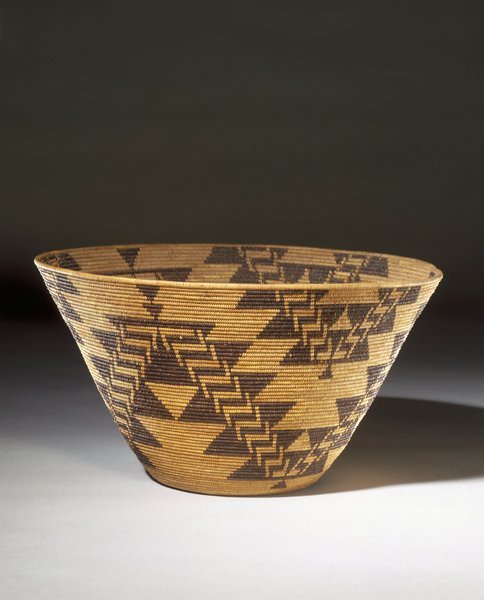Coiled Presentation Bowl Item Number: 06.331.8050 from the Brooklyn Museum

Description
Coiled tan basket with brown, triangle-like designs. The bark design elements are woven in briar root, which has limited distribution in California. While it is a difficult material to trim and work with it is a favorite material of Mary Azbil and she used it especially on baskets she made for family and friends. The design layout requires a great deal of planning and patience. Presentation baskets are invariably fancier than everyday containers and this basket appears to have never been used for food.
Credit Line
Museum Expedition 1906, Museum Collection Fund
Label
These Native American objects represent just a few of the items made in the late nineteenth and the early twentieth century, primarily for sale to dealers and collectors to satisfy the growing market for indigenous products. Finely coiled baskets like the example by the Maidu weaver Mary Kea’a’ala Azbill were in great demand, as were Zuni Kachina dolls. The desire for Eskimo objects such as the ivory pipe engraved with a whale-hunting scene was accelerated by the Klondike Gold Rush in 1897. To appeal to non-Native patrons, Native artists invented new designs using trade materials such as the glass beads forming the embroidered floral arrangement on the northeastern puzzle bag (so named for the way its pieces fold together to keep it closed). Other artists used traditional materials but tailored designs to non-Native aesthetics, as seen in the porcupine-quill box. The Navajo quickly adapted to the Spanish introduction of silver coins and silver mining in the seventeenth century, embellishing their traditional wrist guards with hammered silver. Some artists retained both traditional materials and designs but produced greater quantities of popular items such as the Plains owl pipe bowl made from Catlinite (red pipestone).
Item History
- Made between 1868 and 1933
What
- Name
- Coiled Presentation Bowl
- Identification Number
- 06.331.8050
- Type of Item
- coiled and bowl
- Material
- sedge root, briar root and willow shoot
- Overall
- height 8.0 in
Where
- Holding Institution
- Brooklyn Museum
When
- Creation Date
- between 1868 and 1933
Other
- Classification
- Food/Drink